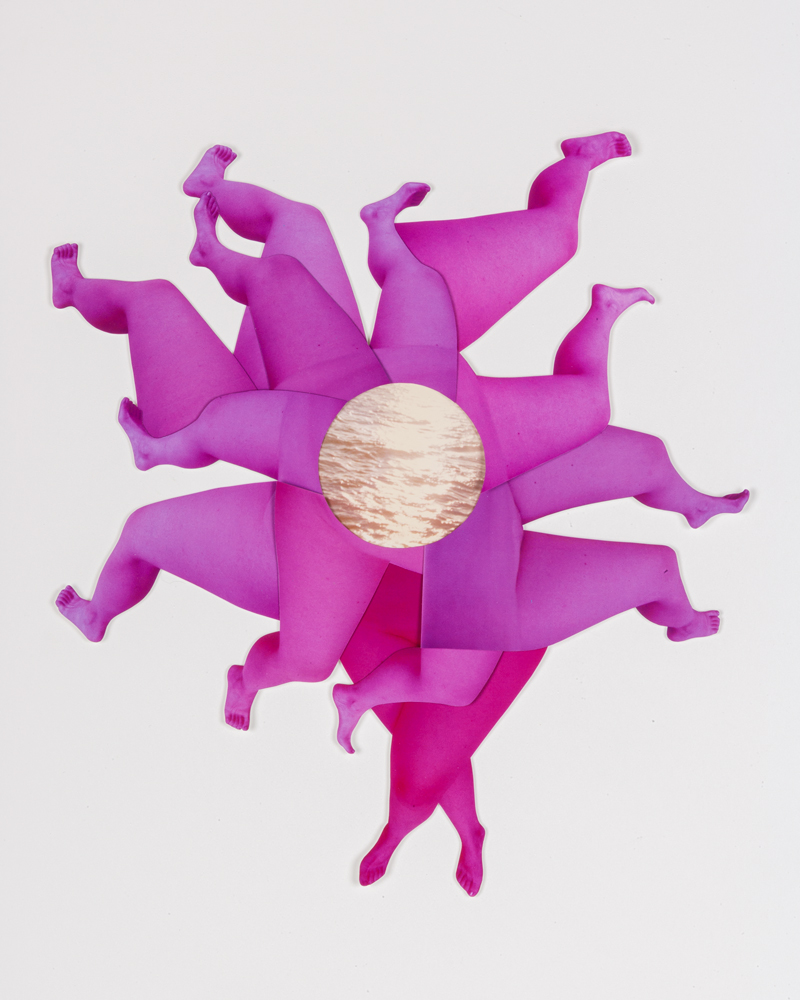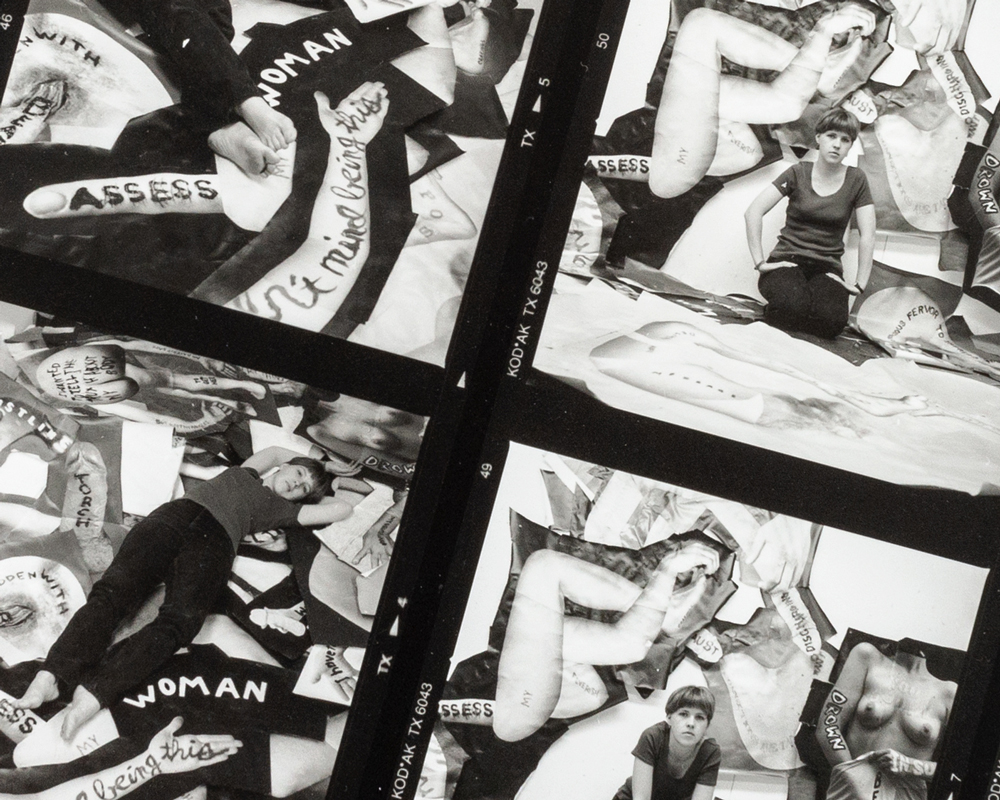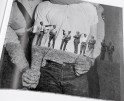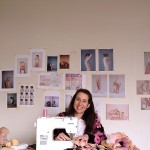Photography + Form Week: Aimée Beaubien
Photography is my first love, but at times I feel that it falls flat for me (how ironic) and I seek out other ways that may tell the story more effectively. While researching for my own photo based projects, I often come across the work of others who push the medium far into new corners through the use of textiles, thread and sculptural elements or any combination thereof. Due to the saturation of images, it seems that some artists have been less inclined to use photography as a language but rather as a form to recreate objects such as textiles, 3-dimensions or a combination of both. The artists featured this week are all inspired by imagery or choose to create sculptural elements with in their imagery to create a layered investigation of their worlds. – Maggie Meiners
I fell in love with Aimée Beaubien’s work when she was part of a group exhibition celebrating the 40th anniversary of the Museum of Contemporary Photography in Chicago. There, her work was cascading in a stairwell, and it was then I knew I needed to know more. Her cut-up photographic collages, installations and artist books explore networks of meaning and association between the real and the ideal: a photographed plant, interlaced vine, woven topography merge into fields of color and pattern and back again expanding the ever more complicated sensations of reading a photograph and experiencing nature. Since then, I have been lucky enough to see Aimee’s work in multiple venues, private homes and book collections– all equally awe-inspiring.
Aimée Beaubien is an artist living and working in Chicago. Beaubien reorganizes photographic experience while exploring networks of meaning and association between the archive, the ephemeral, and the photographic in collages, artist books, and immersive installations. Her work has appeared in national and international exhibitions including at the Museum of Contemporary Photography, Chicago, IL; UCRC Museum of Photography, Riverside, CA; Houston Center for Photography, Houston, TX; Gallery UNO Projektraum, Berlin, Germany; Virus Art Gallery, Rome, Italy; Johalla Projects, Chicago, IL; Chicago Cultural Center, IL; Hyde Park Art Center, Chicago, IL; Lubeznik Center for the Arts, Michigan City, IN; Marvelli Gallery, New York, NY; TWIN KITTENS, Atlanta, GA; and Demo Projects, Springfield, IL. Aimée Beaubien is an Associate Professor of Photography at the School of the Art Institute of Chicago, IL where she has taught since 1997.
Follow Aimée on social media: @aimeebeaubien
Wild, fast growing vines slink through the yard and climb around our house. In my home studio, plants mingle with huge tangles of cut and woven photographs that dangle down from the ceiling in various states of progress and decay. I photograph the ever-changing conditions as plants dry and projects grow.
From my photographs I create collages, artist books and sculpture. In my photo-based installations ephemeral paper structures that accommodate, attach to, climb, trail, cling, spread, creep and rearrange within each new exhibition environment: loudly, brightly. I translate my responses to the vitality of vines by pushing color while imagining how energy is harnessed from the sun in photosynthesis. I reorganize the scale of my photographs to amplify the ambition of vine movements while translating their enviable ability to embrace everything near in acts of remarkable adaptability. Expanded ranges of time are illuminated in environments folding around and stretching into the peripheries of visual and architectural space.
Attentive to perceptual shifts between the depicted and touchable, I manipulate my photographs into becoming a series of moving parts, pushing their capacity to change and to transform. While walking through one of my installations photographic elements slip between recognition and abstraction. Bold leaf shapes and twisting ribbons of photos entwine, cluster and creep. A photographed plant, interlaced vine, woven topography merge into fields of color and pattern and back again expanding the ever more complicated sensations of reading a photograph and experiencing nature.
The conditions of each exhibition site inform a new chain of experiential shifts between visual representation and the physical encounter. Dangling forms gently sway with movement created from air currents, bodies brushing up and passing by. Moving through these constructed environments is exciting and dizzying. Everything is interconnected and the overall effect fights with attention to focus on a single photographic moment.
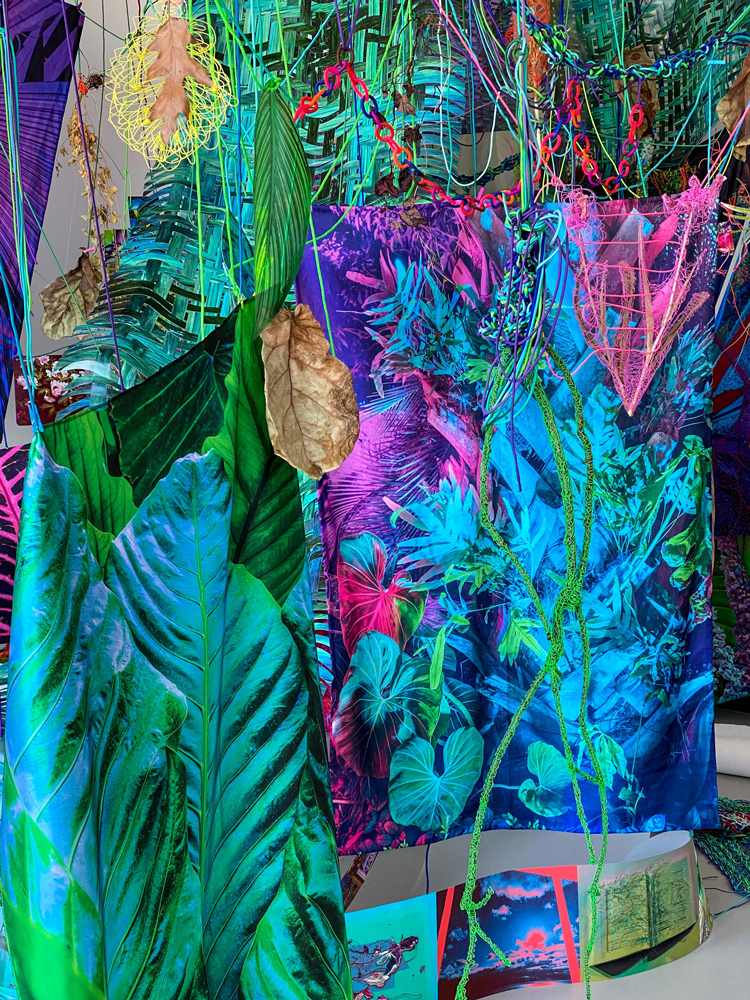
© Aimée Beaubien, Studio view, 2022 Cut-up and woven inkjet prints, printed satin, printed Tyvek, paracord, vintage garden books, leaf drawings, tulip drawings, botanical matter
Tell us about the landscape of your childhood and how you came to be an artist.
Blurry and unfixed of swimming in a converted quarry; balancing along the edges of a dike next to a threatening river; digging in bins of shiny tumbled minerals at a tiny natural history museum; running back and forth through the grassy alley between my grandmother’s and great-grandmother’s homes; watching the commuter train blaze by from our apartment window; drawing trees and leaves in every sketchbook I could get my hands on.
Each summer included a visit with my great-grandmother Gert who repurposed every little scrap of something. Gert had a special dish to hold half of a banana between snacks and a collage taped to the fridge as a reminder to control her appetite. She cut her face from a snapshot and attached it to a rubenesque figure extracted from an advertisement for control top pantyhose. Together we made a special pillow for her cat stuffed with Tingaling’s hair collected from a year of brushings; cut up her wedding dress to sew fancy clothes for her dolls; frankensteined printed scraps together to create personalized greeting cards. Working alongside my endlessly inventive great-grandmother was the start of my lifelong education in orienting myself within the imaginative.
My family was always on the move after attending three different schools at the beginning of high school. I landed in an arts program for the final two years. We had academic classes in the morning, spent the rest of the day in our area of concentration and returned to our major after mess hall dinners. That meant a lot of time in the darkroom preparing two spotted and matted gelatin silver prints for critique each Friday. The days are still best when they begin with reading before heading into the studio to work.
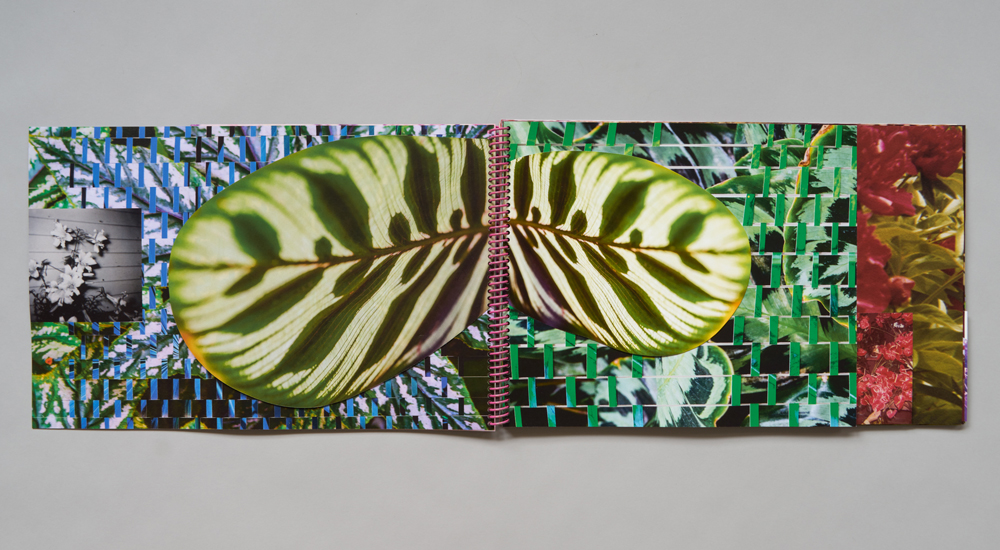
© Aimée Beaubien, Cuttings, 2017 In collaboration with Jennifer Keats, The Donut Shop printed on bond, vellum, film, spiral bound 11 x 17 inches
What was your first meaningful encounter with art?
Zooming in and out with my body by walking backwards and forwards across the length of a museum gallery to experience the process of a gigantic image breaking down into tiny painted marks and then coming back together again in Georges Seurat’s A Sunday on La Grande Jatte from 1884. Standing in a very long cue that rambled all of the way through a blockbuster exhibition. A mighty force outside of my body determined the pace with other people’s elbows becoming the framing device through which I caught glimpses of paintings in passing. Climbing and descending a marble staircase to move through Sky Above Clouds but never able to get close enough to Georgia O’Keefe’s painting from 1965. Somehow all three of these early experiences are entwined with memories of how my body felt in direct relationship to the art.
How does photography influence/inform this body of work and vice versa?
I think in photographs. From a very young age I gravitated towards collisions of pictured realities in photographic collage. I understand my surroundings in relation to the chasm between the experience and the many different ways that experience can be translated to appear in our visual culture. Recently I have been incorporating other materials in direct conversation with photography. Hanging within my installation are leaves from multiple vantages. I look at leaves through my camera while they are alive, growing, fallen and dried. Leaves dangle from brightly colored paracord: photographs of leaves; dried and drying leaves, leaves that I have drawn around with a 3-d pen and gold leafed leaves. The encounter is with the idea of a leaf pictured in various states of life and decay and very often it is not so easy to discern one from another.
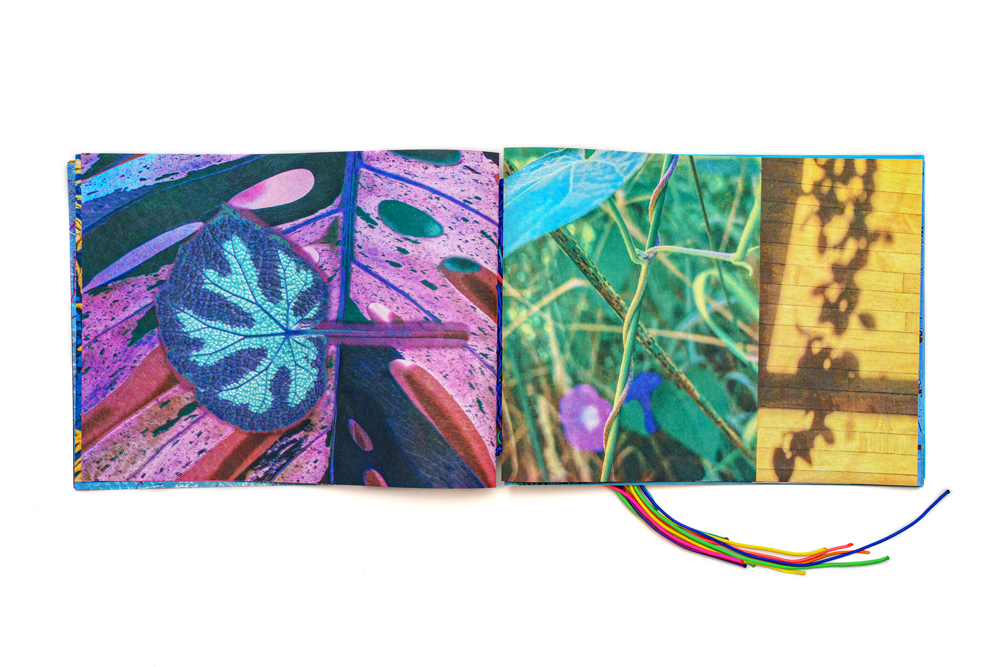
© Aimée Beaubien, Unfurl Unfold: The touch of a leaf, the page in a book felt, 2021 in collaboration with Angee Lennard, Spudnik Press Cooperative inkjet and silkscreen on Tyvek, unique spreads from vintage garden book, hand-sewn French link stitch binding with paracord
How does photography integrate into your current medium? Or if you are still using photography how does it relate to the other materials that you are using?
Photography is my first move. The invitation from my great-grandmother to cut up pictures made a profound impression on me. Some forms of photography are endlessly reproducible making that much easier to take the liberty to slice apart my photographs to reconstruct images. This gesture of repositioning; of visually describing the overlap; conjuring dissonance; exploring under, through and between aligns with how I process the complexities of life.
Most of my decisions start with simple questions. What happens if I pierce, puncture, stab, slice, cutup photographs? How can I experience my photographs in the round? What happens if the thing I photograph is in direct conversation with the thing itself? How can I further explore the slipperiness of signs and meanings in the space between the experience of a living organism and its likeness in a photograph commingled in various states of progress and decay?
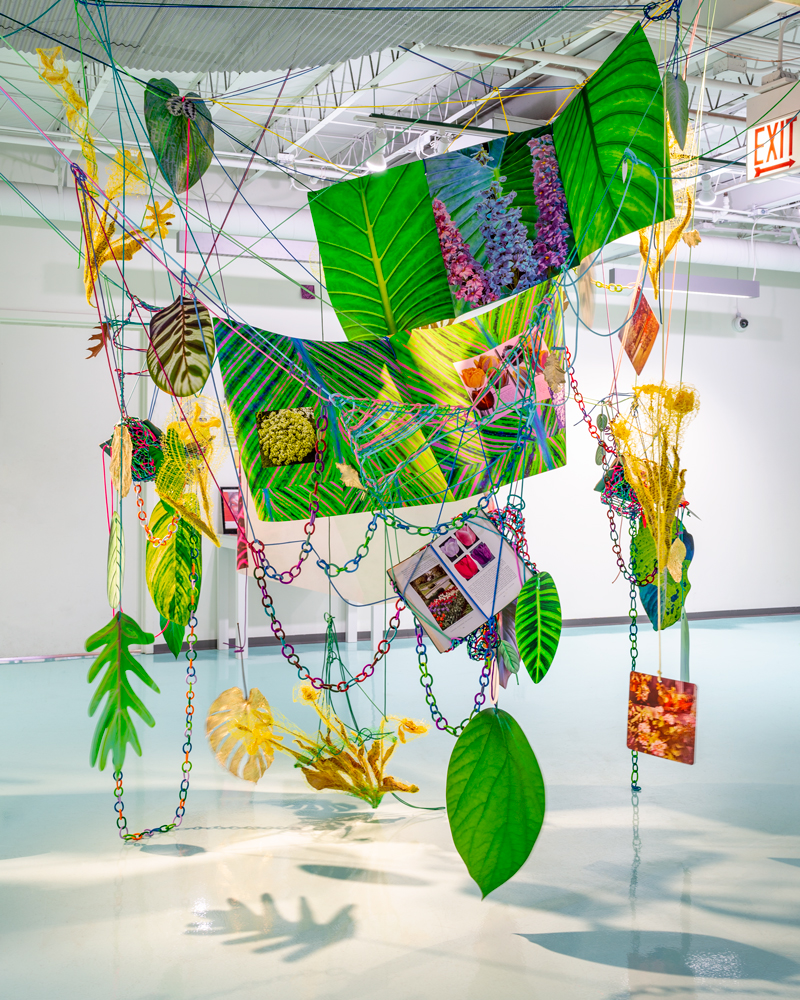
© Aimée Beaubien, Garden Flowers in Color (installation view), 2020 Cut-up and woven inkjet prints, paracord, porcelain chains, polymer chains, leaf drawings, tulip drawings, gilded leaves, pressed leaves, vintage garden books. Dimensions variable Exhibition: Artists Run Chicago 2.0, Hyde Park Art Center, Chicago, IL
What process is used in deciding what material to use when it comes to taking it from straight photography to something of another dimension?
I make lots of work prints and begin testing different material forms. At the very start of the pandemic I walked through the same school hallways where I had been a young art student in the late 80’s and early 90’s experiencing another devastating epidemic. Little had been known about the burgeoning AIDS crisis. The fear of touching resurfaced before transmission was understood. During the early days of lockdown I began making paper maché casts of my hands and arms without knowing where it would lead. Then I began twisting the forms as they morphed into a conversation with some of my early photo collage bodies. I started tying them up in different configurations in my studio. Soon I found myself painting and drawing on the arms and attaching photographs to the skin while thinking about the photographs that have made a lasting imprint on me. I started photographing my hands and cutting silhouettes of my hands into my photographs of plant forms. All of these different depictions of hands will hang in space and echo throughout an upcoming installation for SF Camerawork titled Matter in the Hothouse.
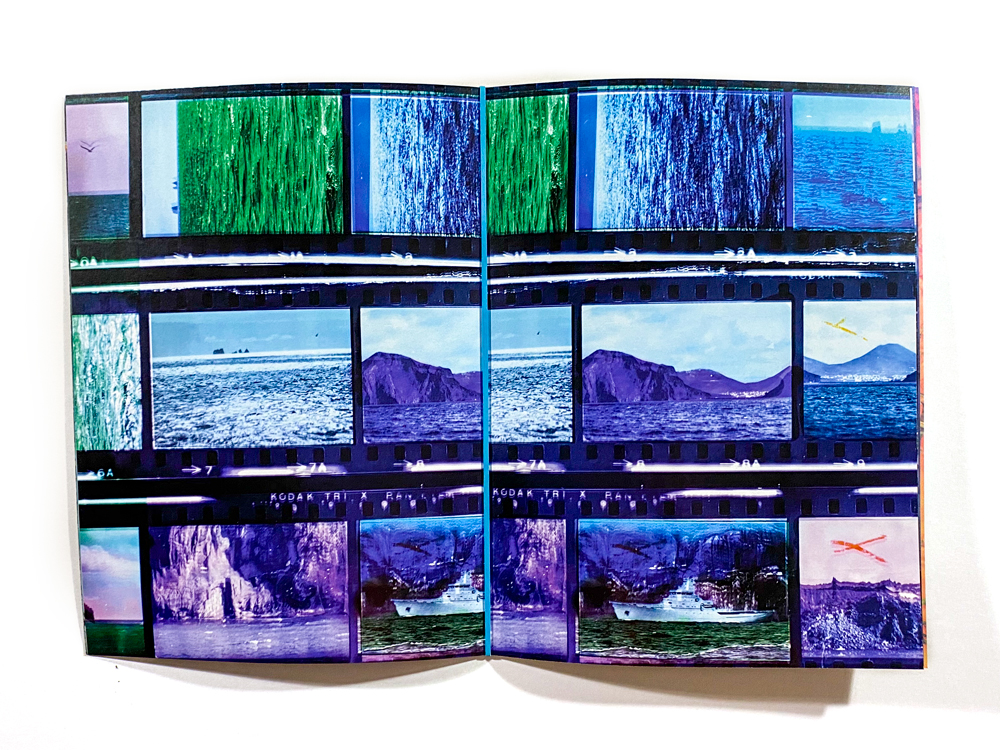
© Aimée Beaubien, Contact, 2019 in collaboration with Jennifer Keats, The Donut Shop three zine set, rubber band binding 12.5 x 9.5 inches
What were you reading, watching or listening to while making this work? If you don’t remember, can you tell us what pieces of literature, art or film may have helped direct this work?
It is hard to imagine how I would have managed the bleakest periods of the pandemic without access to my library and streaming content. I am grateful to so many authors. I find myself regularly circling back to autofiction and metafiction. Some recent delights include To Write As If Already Dead by Kate Zambreno; Inferno: A Poet’s Novel by Eileen Myles, I Confess by Moyra Davey. I listen to a variety of sources that compliment different stages of my working processes that include lectures, podcasts, recorded books, and public radio. Sometimes I purposefully seek out content that drives through current work. While cutting up leaves and weaving together vines I listened to Underland: A Deep Time Journey by Robert Macfarlane; Entangled Life: How Fungi Make Our Worlds, Change Our Minds & Shape Our Futures by Merlin Sheldrake; The Overstory by Richard Powers. Other things I read or listened to that I am still thinking about are A Swim in a Pond in the Rain by George Saunders; On Freedom: Four Songs of Care and Constraint by Maggie Nelson; Klara and the Sun by Kazuo Ishiguro; The Great Believers by Rebecca Makkai; Fake Like Me by Barbara Bourland. And nothing can quite compete with a compelling read that can be accomplished in one sitting like Peter Hujar’s Day by Linda Rosenkrantz and Hidden Mother by Laura Larson; both completely caught me by surprise with their intimacy and immediacy and inherent relationships to photography.

© Aimée Beaubien, Studio view, 2021 Paper maché, paint, color pencil, inkjet prints, paracord 38 x 34 x 8 inches
What are you working on currently and does it relate to photography, if so, how?
At this very moment I am packing material to ship to SF Camerawork where I will build a large-scale immersive photo-based installation with the level of density I have been dreaming about for years. The garden is my starting point because it intersects with the history of photography, science, the everyday, ephemerality, kinship, life cycles of growth, struggle, loss and renewal. In December I walked through a swamp sanctuary completely dazzled by the shifting qualities of light in variable densities of this forested wetlands. The interconnectedness within the largest remaining, virgin bald cypress forest was galvanizing and spurred my commitment to build my own photo jungle. So many people speak woefully about the endless streams of photographs and their anxiety about photography. I wade into the stream to embrace the multifarious applications of the medium, the shifting contexts and the wonderfully confounding flexibility of photographic meanings.
It is hard to imagine how I would have managed the bleakest periods of the pandemic without access to my library and streaming content. I am grateful to so many authors. I find myself regularly circling back to autofiction and metafiction. Some recent delights include To Write As If Already Dead by Kate Zambreno; Inferno: A Poet’s Novel by Eileen Myles, I Confess by Moyra Davey. I listen to a variety of sources that compliment different stages of my working processes that include lectures, podcasts, recorded books, and public radio. Sometimes I purposefully seek out content that drives through current work. While cutting up leaves and weaving together vines I listened to Underland: A Deep Time Journey by Robert Macfarlane; Entangled Life: How Fungi Make Our Worlds, Change Our Minds & Shape Our Futures by Merlin Sheldrake; The Overstory by Richard Powers. Other things I read or listened to that I am still thinking about are A Swim in a Pond in the Rain by George Saunders; On Freedom: Four Songs of Care and Constraint by Maggie Nelson; Klara and the Sun by Kazuo Ishiguro; The Great Believers by Rebecca Makkai; Fake Like Me by Barbara Bourland. And nothing can quite compete with a compelling read that can be accomplished in one sitting like Peter Hujar’s Day by Linda Rosenkrantz and Hidden Mother by Laura Larson; both completely caught me by surprise with their intimacy and immediacy and inherent relationships to photography.
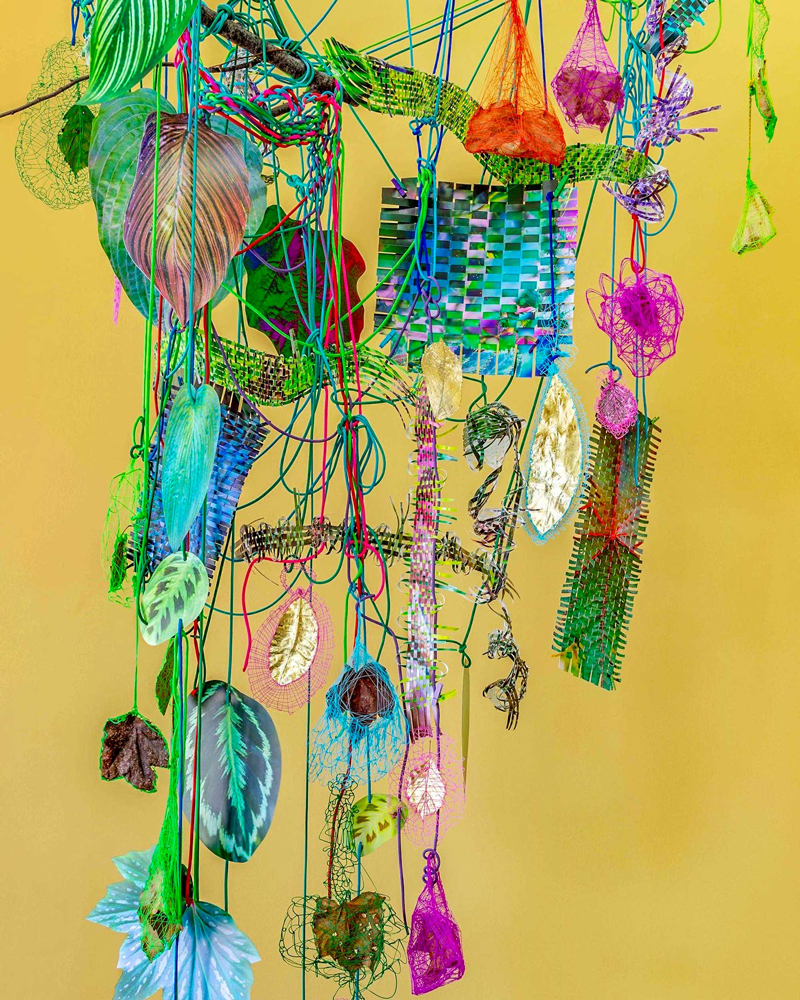
© Aimée Beaubien, Plumb and Twining (installation detail), 2020 cut-up and woven inkjet prints, gilded leaves, leaf drawings, paracord, branches dimensions variable Exhibition: Kismet, Monaco Gallery, St. Louis, MO
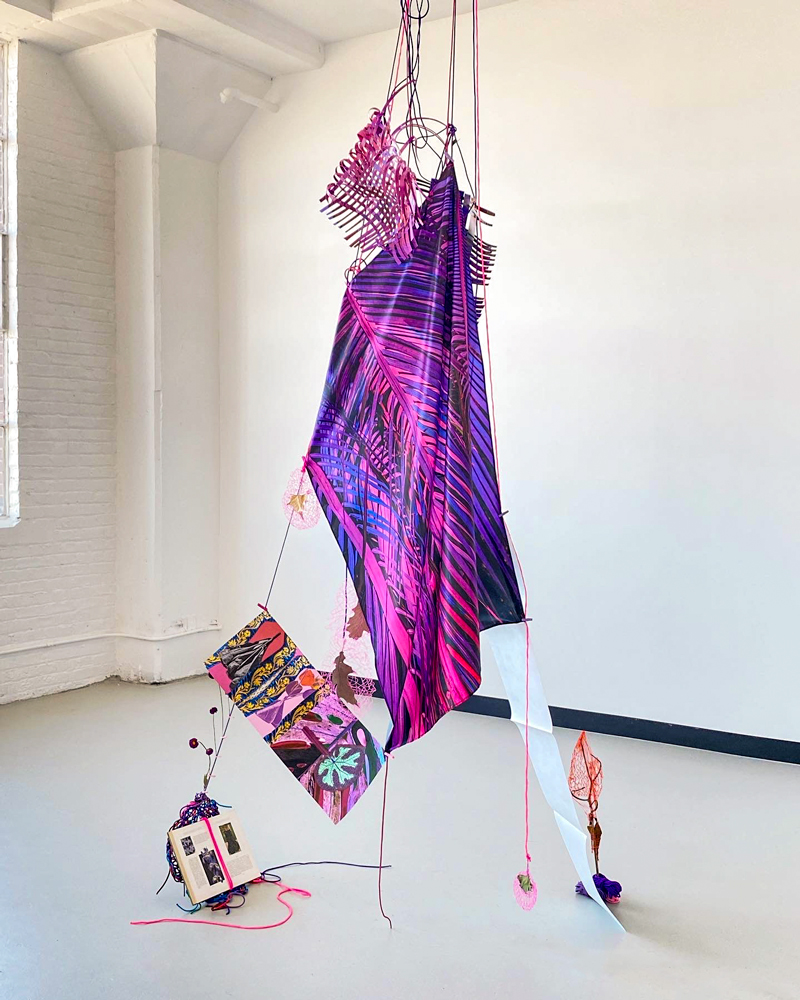
© Aimée Beaubien, Studio view, 2021 cut-up and woven inkjet prints, printed satin, printed Tyvek, paracord, vintage garden books, botanical matter

© Aimée Beaubien, Hothouse Picture-Cyclopedia (installation view), 2020 Cut-up and woven inkjet prints, printed satin, printed banner material, gilded leaves, leaf drawings, gilded leaves, dried plant matter, paracord, miniature clothespins, polymer chains, porcelain chains, grow lights on fabric cord, vintage garden books dimensions variable Exhibition: New Formations, Catherine Edelman Gallery, Chicago, IL
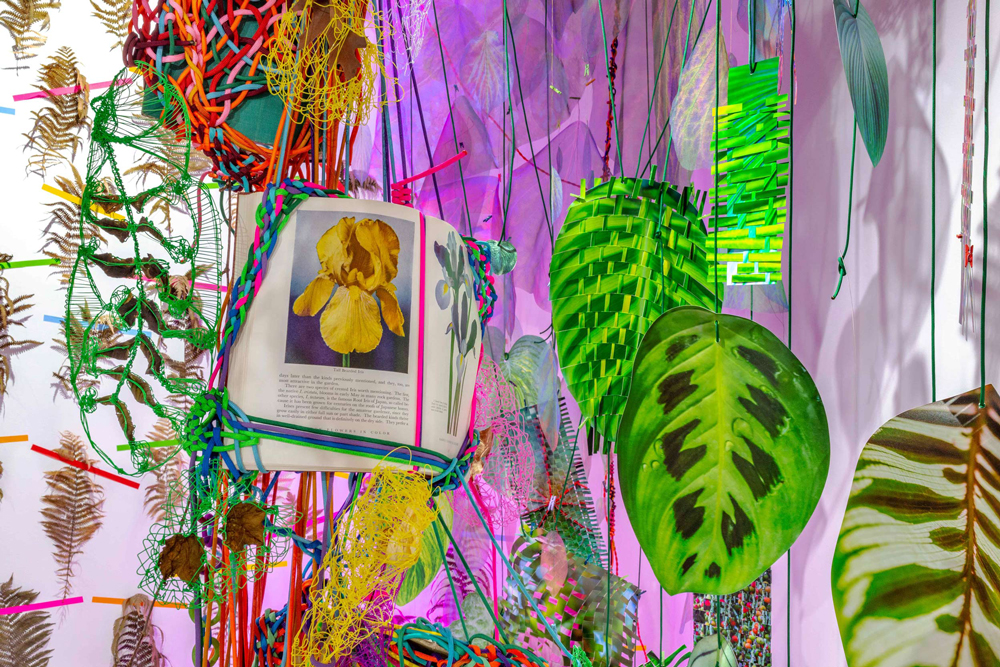
© Aimée Beaubien, rooted-looping-scrambling-rambling-tangling-twining-tendrils (installation detail), 2020 Cut-up and woven inkjet prints, paracord, porcelain chains, polymer chains, leaf drawings, tulip drawings, branch drawings, gilded leaves, pressed leaves, vintage garden books dimensions variable Exhibition: rooted-looping-scrambling-rambling-tangling-twining-tendrils, 062 Gallery, Chicago, IL
Maggie Meiners (b.1972, Chicago) Maggie Meiners is an interdisciplinary artist whose work revolves around self-critique. Heavily influenced by image culture and how it personally affects her, Meiners deftly deploys photography, stock imagery, film stills, cultural artifacts and magazines to tackle subjects such as identity, gender, and social status. Using appropriation, assemblage, film making and installations, Meiners explores the psychological affects of popular imagery on her psyche.
Her interests lie in deconstructing the current cultural narrative as a way of empowerment and defining her personal identity. The internal conflicts that manifest from the constant barrage of the media as well as societal expectations (both self-imposed and external) within the current social construct are also represented in her work. Using these varied modes and mediums, Meiners’ work highlights feminism and contemporary notions of gender, domesticity, beauty, consumption, and body image. Humor and subversive messaging in Meiners’ work is relayed as an abundance of bright, often lurid colors and textures in jarring, frenetic, and imperfectly arranged pieces. Such arrangements evoke the essence of simultaneous desire and absurdity, a psychological manifestation of our culture of perfection and truth.
Maggie’s art has been widely exhibited and remains in the permanent collections of the Illinois Institute of Art, Wheaton College, Harrison Street Lofts, Fragomen, Del Rey, Bernsen & Loewy, LLP and numerous private collections. In addition, her work was on loan at the American Embassy in Uruguay from 2016-2019. Maggie had her first solo exhibition in 2005 at The Union League Club of Chicago– one of the most esteemed private collectors of art in the country and is represented by the Anne Loucks Gallery in Glencoe IL.
Follow Meiners on Instagram: @MaggieMeinersProjects
Posts on Lenscratch may not be reproduced without the permission of the Lenscratch staff and the photographer.
Recommended
-
Ricardo Miguel Hernández: When the memory turns to dust and Beyond PainNovember 28th, 2025
-
Pamela Landau Connolly: Columbus DriveNovember 26th, 2025
-
KELIY ANDERSON-STALEY: Wilderness No longer at the Edge of ThingsNovember 19th, 2025
-
Jackie Mulder: Thought TrailsNovember 18th, 2025
-
Accidental Evidence: Mike Mandel and Chantal ZakariOctober 22nd, 2025

